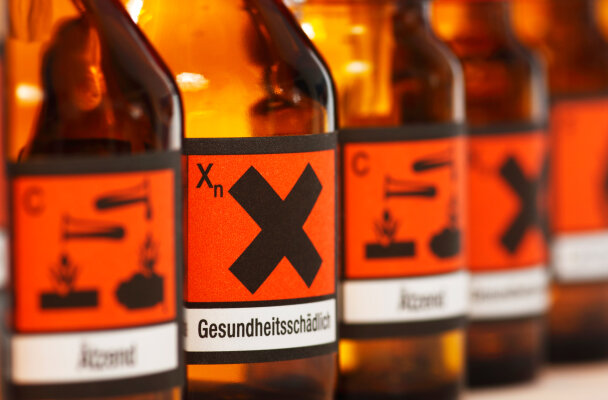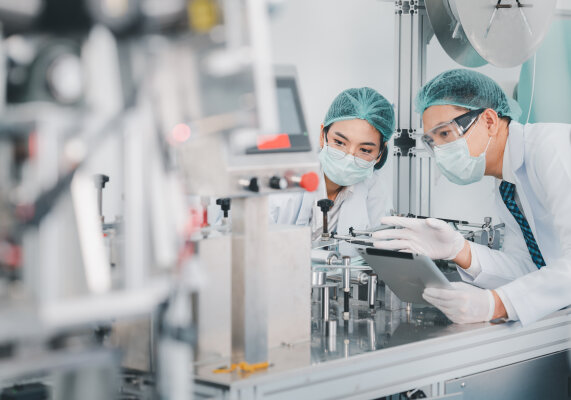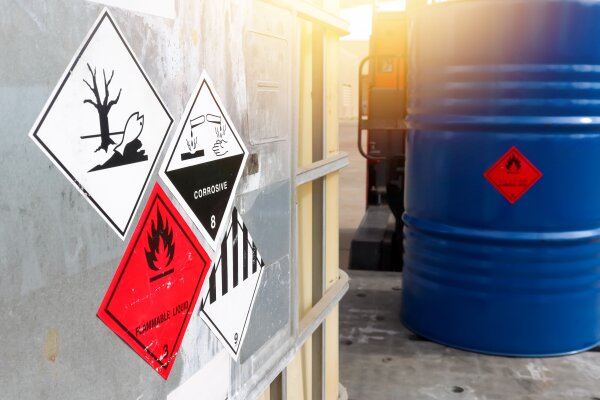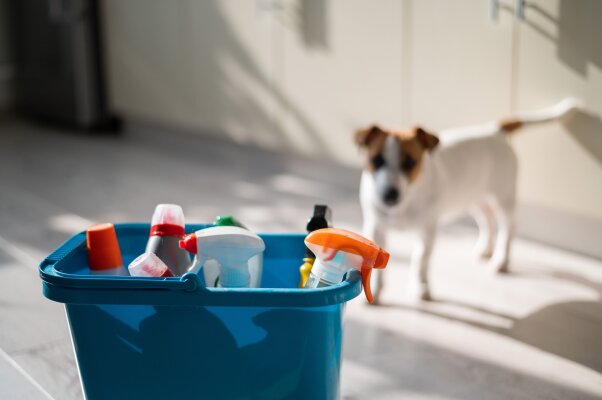Sterilization: definition and methods

The sterilization process is used to sterilize surfaces and objects - which is essential in many areas. This effectively kills harmful microorganisms and pathogens. In this blog post, we have summarized how the definition of sterilization differs from cleaning and disinfection, which substances can be sterilized and which processes are suitable in each case.
Difference: cleaning, disinfection, sterilization
When it comes to reducing the risk of infection, the terms "cleaning", "disinfection" and "sterilization" are often thrown together. In fact, all three processes are entirely different methods that differ from one another in terms of how they are carried out and the possible areas of application. In order to define sterilization, therefore, it must first be distinguished from cleaning and disinfection.
Cleaning
Cleaning is primarily a removal of dirt, which may or may not be visible. Thus, this process belongs to the treatment of surfaces and objects - e.g. wiping down work areas or cleaning floors. Potentially harmful microorganisms are removed mechanically, but not killed.
Cleaning can therefore be used primarily as the first step in a disinfection or sterilization process. In contrast to these two processes, cleaning removes visible soiling from surfaces so that the killing of germs can follow in the next step. The germ reduction is then already 50% to 80%.
Disinfection
Disinfection, on the contrary, ensures a germ reduction of 84% to 99.9%, so that any risk of infection can be effectively minimized. That is why this process is used in many areas, ranging from medical facilities to food production and laboratories of all kinds. Meanwhile, disinfection is also increasingly used in private environments.
Depending on the type of disinfectant and the selected procedure, the germs and pathogens are inactivated or killed. Attention must also be paid to the ingredients of the disinfectants, which can be bactericidal, fungicidal, virucidal and/or sporicidal, for example. In this way, the method can be ideally adapted to the undesirable microorganisms, which naturally also increases the effectiveness of the disinfection.
Sterilization
If complete sterilization is required, a sterilization process is used. Sterilization involves killing or inactivating all microorganisms, which include, for example, bacteria, viruses, spores and also prions. These are attacked at all stages of development, so that any germs that remain can neither multiply nor have any harmful effects on the human body.
By definition, an item or surface is considered sterile when the probability of a surviving germ is less than 1:1,000,000 (. This can be achieved in sterilization by various methods and procedures, which can be primarily divided into physical and chemical sterilization methods. Sterilization has become indispensable, especially in the medical field.
Sterilization: definition and differences
Sterilization is not just sterilization - different types and procedures can be differentiated, each of which entails a different definition of sterilization. However, what they have in common is that sterilization is carried out for hygiene purposes, so that a completely germ-free result is achieved at the end. Sterilization in an autoclave is possible for liquids as well as for solids and for biological hazardous substances.
Sterilization of liquids
Liquids must be sterilized open or vented, which can complicate this procedure. There is also a risk that the liquid will boil over or cause the storage vessel to burst. The definition of liquid sterilization is to transfer heat energy by condensation to the bottle containing the liquid.
This requires a heating and equilibration period as a first step, followed by an actual sterilization phase. For most liquids, it is necessary to perform sterilization at a minimum of 121°C for 20 minutes. After this, the sterile goods must be brought to a safe withdrawal temperature, so that a cooling time must be observed.
Solid state sterilization
Solids can be sterilized more easily in the autoclave, whereby particular attention should be paid to optimal venting and to the loading of the autoclave chamber. Typical examples of solids include glassware, filters, pipette tips and bags as well as textiles and porous materials.
During sterilization, ensure that the air present in the autoclave chamber and in the sterilized items has been completely removed - otherwise the sterilizing effect could be reduced. Steam generation generates the necessary heat energy and transports it to the surface of the solids, where microorganisms are inactivated and killed.
Sterilization of biological hazardous substances
If, on the other hand, biological hazardous substances are to be hygienically processed using sterilization, the autoclave must be equipped with exhaust air filtration. This upgrade usually takes the form of a filter cartridge made of a PTFE membrane with a small pore size. During the heating and sterilization phases, the condensate is retained and filtered in the pressure vessel so that germs and microorganisms cannot escape or are displaced.
Since biological samples can differ in consistency and shape (think, for example, of bones, plant tissue or sputum), the starting material must be converted into a suitable form before sterilization. Means of choice for this are often homogenization and pulverization.
Sterilization processes at a glance
There is no universal procedure for sterilization that covers all applications. Instead, the procedure must be adapted to the properties of the sterilization material and to the type and extent of contamination with harmful microorganisms.
The categories are thermal, chemical and physical sterilization, which are based on different approaches and are suitable for different objects and surfaces. In order to facilitate the selection, we have summarized the sterilization processes at this point:
Sterilization with autoclave
Autoclaving is probably the best-known sterilization process. This involves the use of a so-called autoclave, which consists of a pressure vessel that can be sealed gas-tight and a lid that can be sealed air-tight. Steam is generated in the device, so that the definition of sterilization here corresponds to the cleaning effect of moist heat.
The material to be sterilized is treated for 5 minutes at 134°C or for 20 minutes at 121°C with an overpressure of two to three bar, which creates an atmosphere saturated with water vapor. In this way, textiles, rubber, heat-resistant plastics and instruments in particular can be sterilized. It is important that the autoclave undergoes regular validation to ensure that it meets the technical, organizational and operational requirements for steam sterilization.
Sterilization with hot air
The use of hot air belongs to physical disinfection and sterilization and is classified in the "dry heat" category. In this process, the item to be sterilized is surrounded by air at approx. 180°C for about 30 minutes in order to kill and inactivate microorganisms on the surface. Usually, a special hot air sterilizer is used for this purpose, which can completely surround the item.
Although the use of hot air ensures a high level of sterilization hygiene, not all objects and surfaces can be treated with it. This is mainly due to the large amount of heat generated - if an object is not heat resistant, it would simply be damaged. Therefore, hot air sterilization is primarily used for metal, glass and anhydrous liquids.
Tyndallization
Tyndallization or fractionated sterilization is a procedure named after the Irish physicist John Tyndall and developed as early as 1850. The sterile material is heated to about 100°C for about 30 minutes on each of several subsequent days and then stored at room temperature. Vegetative bacteria and fungi are killed, while stationary and heat-stable spores suffer heat shock.
The sample is then incubated at 37°C for 12 hours or further stored at room temperature, allowing the stationary spores to germinate into vegetative cells. If the material is heated again to 100°, these persistent representatives can also be killed. In this way, germs can be significantly reduced. However, only items that have the potential of germinating microorganisms can be considered for this process (think of heat-sensitive foods, for example).
Sterilization with gas
Certain gaseous substances can also be used for hygienic sterilization. In order to kill microorganisms, the gases act on the dry objects and surfaces at temperatures between 50°C and 60°C. The gases are then released into the environment. For example, formaldehyde, ozone, hydrogen peroxide and ethylene oxide can be named as typical gases for this process. The aeration time is between 30 minutes and 6 hours.
Gas sterilization irreversibly changes the protein of harmful (and also harmless) microorganisms so that they become inactive. One of the many advantages of this process is that the surfaces are dry after sterilization. The use of gas is particularly widespread in the food industry and in the sterilization of PET and HDPE bottles.
Plasma sterilization
Thermolabile materials (such as syringes and infusion sets made of plastic) as well as plastic packaging films are often sterilized using plasma sterilization, as this does not require high temperatures. In this hygienic sterilization process, plasma discharges are generated by high-frequency waves and microwaves. This even kills prions, which are characterized by particular tenacity.
The sterilizing effect results both from the plasma-generated UV radiation and from the formation of free radicals (chemically aggressive substances) and ion bombardment of the microorganisms. The effectiveness has been scientifically proven in the meantime, but the purchase of corresponding devices is associated with rather high costs. Also, the surface of the sterilized material can be activated, altered and in some cases even decomposed.
Sterilization with radiation
Radiation-chemical mechanisms of action can ensure that germs and pathogens are effectively killed. This definition of sterilization is based on the application of ionizing radiation by UV, gamma or X-rays. Electron bombardment is also possible, which is often found in industrial contract sterilization (for example, to sterilize disposable medical devices).
The high energy form of the radiation releases free hydrogens, hydroxyl radicals and peroxides from the molecules. These can cause severe intracellular damage to microorganisms, making it impossible for these germs to multiply and survive. With UV radiation, on the other hand, pathogens are not ionized, but their cell structures are destroyed. This variant can be used over a wide area and can be found in hospitals, for example.
Sterile filtration
Sterile filtration or sterilization filtration is primarily used for vaccines and liquid culture media that have heat-sensitive properties and are therefore not suitable for many other processes. In this type of filtration, the solution is filtered through sterile membrane filters with a pore size of 0.22 µm - microorganisms such as bacteria do not pass through and remain in the filter.
For some applications, even smaller filters (0.1 µm) occur, which are suitable for targeted growth experiments of certain bacterial cultures. A disadvantage of sterile filtration may be that some bacteria (such as Mycoplasma and Spirochaetes) cannot be retained due to their size and/or shape. Incidentally, many membrane filters can themselves be sterilized and reused, as the bacteria, viruses and co. in them are killed. Usually this happens with gas sterilization.
Chemical sterilization processes
The term chemical sterilization covers all processes in which cold sterilization is carried out using toxic substances. Germs and pathogens denature and die. It is important to ensure that the sterilized material is suitable for these sterilization processes - any change in the composition of the material or any impairment of the surface must be avoided.
Chemical sterilization processes include gas sterilization as dry antiseptic (for example with formaldehyde or ethylene oxide) and wet antiseptic (for example with hydrogen peroxide, dissolved ozone or peracetic acid). These processes are mostly used when thermolabile materials are involved. Otherwise, steam sterilization is almost always preferred.
Sterilization: definition and possible applications
According to the current definition, sterilization is a process in which microorganisms and pathogens are completely killed and inactivated - one can speak of complete sterilization. Various chemical, physical and thermal processes are used, which can be adapted to the respective areas of application and material properties of the sterilization material. This means that there is a suitable method for every requirement - from hospitals to the food industry.
Do you have any questions on the subject or would you like to suggest a topic? Please feel free to contact us by phone at +49 30 2096579 00 or send us an e-mail to info@medsolut.com.




